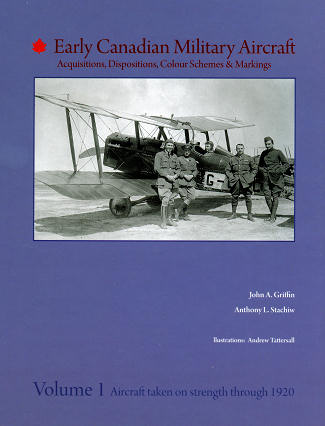 Aviaeology
has been earning themselves quite a reputation for research and accuracy when it
comes to their decal sheets on Canadian subjects. They have now added book
publishing to their list and, to me, this is their first effort.
Aviaeology
has been earning themselves quite a reputation for research and accuracy when it
comes to their decal sheets on Canadian subjects. They have now added book
publishing to their list and, to me, this is their first effort.
Aviaeology's Early Canadian Military Aircraft #1
|
PRICE: |
C$59.00 plus shipping |
|
REVIEW & |
Scott Van Aken |
|
NOTES: |
Acquisition,
Disposition, Color Schemes and Markings. |
 Aviaeology
has been earning themselves quite a reputation for research and accuracy when it
comes to their decal sheets on Canadian subjects. They have now added book
publishing to their list and, to me, this is their first effort.
Aviaeology
has been earning themselves quite a reputation for research and accuracy when it
comes to their decal sheets on Canadian subjects. They have now added book
publishing to their list and, to me, this is their first effort.
One rarely thinks about the very early days of military aviation in one's own country and to me, Canada's air force starts were a complete unknown. I had assumed that they'd started prior to WWI with some very early Curtiss types, as Curtiss was building aircraft in Canada at the time, but I was very much wrong in this assumption. In fact, the Canadian military had very little use for aircraft after WWI and were it not for the RAF having a huge surplus of aircraft that it gifted to the various Commonwealth nations (an Imperial Gift), it seems likely that the RCAF would not have been formed until many years later.
116 aircraft were part of the Imperial Gift with a smattering of types, many of which had not seen any service at all. This includes the Avro 504K, DeHavilland DH.9, SE.5A, Bristol F2.B as well as USN aircraft left behind at Canadian coastal based that includes the Curtiss HS-2L. As Canada was instrumental in training Commonwealth crews, there were a number of Curtiss JN-4 (Can.) aircraft available and add to it a lone Fairey IIIC Transatlantic left un-finished after the USN's NC-4 completed the first trans-Atlantic crossing.
The authors have decided to break the book down into chapters that cover each aircraft type. This includes any salient differences in camouflage and markings so there are a considerable number of color four views of these planes with detailed descriptions of the scheme used on every page.
Each chapter starts out with how the aircraft were obtained, followed by the operational use of nearly every one. The level of research into this is first rate as it seems everything known about each aircraft has been included in the book. This includes some superlative period photographs of the aircraft and the men who flew them.
Many of these aircraft participated in ground-breaking flights and operations. I found it particularly interesting that the most used type of all of these was the Curtiss HS-2L flying boat. Not only were the original batch well used, but many replacements were purchased to fill in where the originals had to be scrapped or were lost in accidents.
In addition to all this, there are several pages of scale drawings of each type in 1/72 or 1/96 scale, a section on general camouflage and markings from pages of the original government manual on the subject, Maps of bases and the route of the Trans-Canada Flight as well as tables on each individual aircraft by serial and its final disposition. Of course, there is much more in these pages for you to discover on your own.
In all it is an exemplary work that shows the effort that was put into it. It is a book that I thoroughly enjoyed reading and one that I give my highest recommendation.
June 2011
My thanks to www.aviaeology.com for the review book. You can get yours direct.
If you would like your product reviewed fairly and quickly by a site that averages thousands of visits a day, please contact me or see other details in the Note to Contributors.